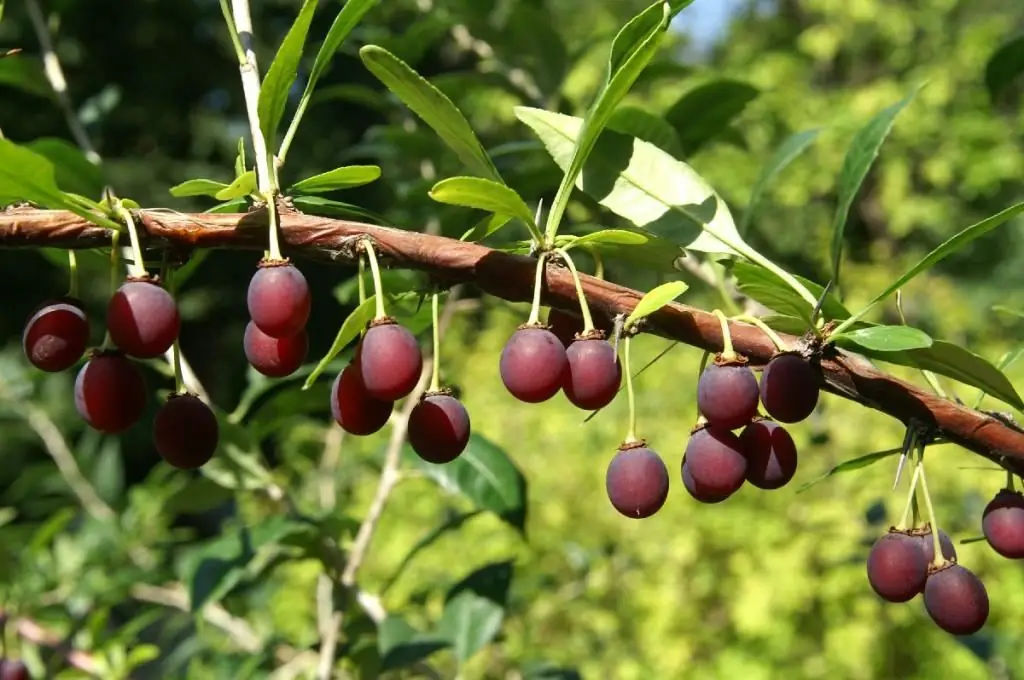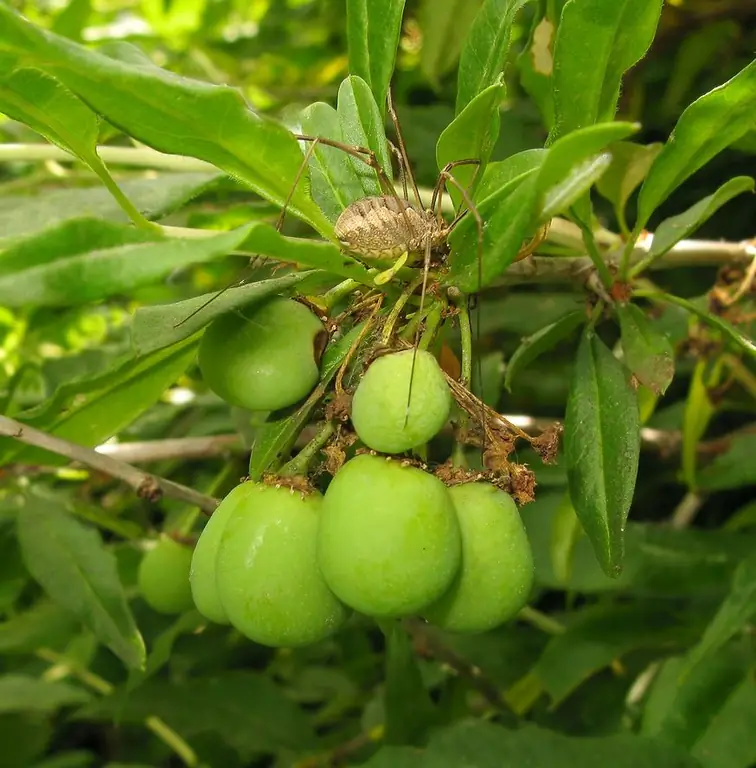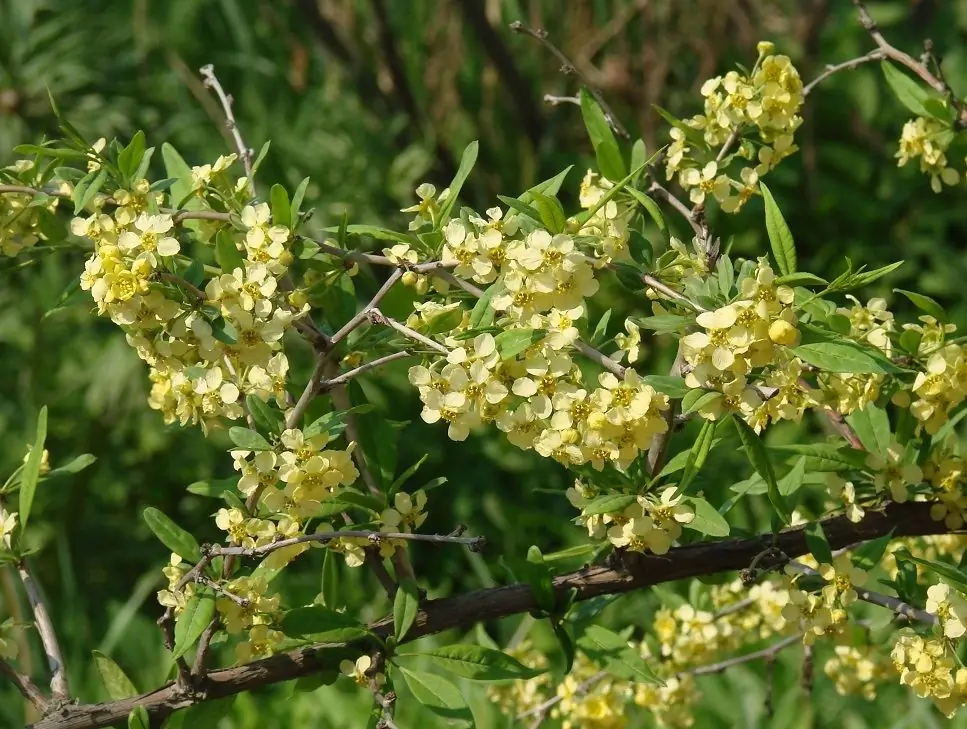Princepia is a beautiful ornamental shrub, but it is popular not only because of its beautiful appearance, but also because of its healing properties. The fruits of Chinese Princepia taste like cherries, and the leaves and shoots of this plant are very fond of caterpillars.
Appearance of the plant
Princepia sinensis itself is a thorny perennial shrub with an incredible growth rate. In a very short time, this plant reaches a height of two meters.
Princepia is very fond of landscape designers for its unusual crown, formed from twig-like shoots. And indeed, this shrub looks very elegant in the garden, and the Chinese princepia also looks great in a hedge. The young bark is usually gray in color, which blends well with the young shoots of a green hue. The bark itself is flaky and has prickly thorns, very long - up to 2 cm. But there are few of these thorns on the bush.

Reappearing leaves are arranged alternately, but over time, unusual bunches are obtained from them. Leaves lanceolate elongatedshape, sometimes with an elongated tip. In summer, the leaves have a soft grassy color, but the lower part of the leaf always remains lighter. In autumn, the leaves of the Chinese princepia become the color of ocher and various shades close to it. Very rarely the foliage may be brown.
Flowering and fruits
Chinese princepia blooms in late May and early June. It is during this period that small inflorescences appear on the plant, golden or yellow in color. These inflorescences are collected in small bunches and hide in the axils of the leaves. After the plant flourishes, fruits appear on the branches, which in appearance are a bit like cherries. Fruits in the form of drupe balls are slightly flattened on the side. The berries themselves are red and very useful, so they are often used in various preparations. Bones with a characteristic relief similar to a peach pit.

If Chinese princepia is grown as a fruit crop, then at least four such plants should grow in the garden. This bush looks great all year round, and in the autumn period it especially stands out against the background of other shrubs.
Princepia reproduction
Propagation of Principia does not cause trouble for gardeners. Seeds of Chinese Principia, when collected on their own, germinate perfectly, without the need to use auxiliary solutions and components. Young seedlings and cuttings take root with ease and speed, allowing the growth of several strong young plants. It also does not require the use of additional solutions andgrowth accelerators. Seed germination is quite high and varies from 92 to 95%.
Seeds are usually sown in early spring. You can do this in late autumn, but the stratification of seeds is required for four months at a temperature of -2 degrees.

Princepia sinensis is also propagated by young cuttings and layering. Compared to seeds, the cutting method is not as effective, since the germination rate is quite low - only 55%. But this method also takes place and is used quite often. And for better development of the root system, the cuttings are soaked in a growth stimulator.
Most often, the reproduction of Chinese princepia is carried out using layering. This method is considered the simplest. With this method, you need to select the strongest and he althiest shoots, tilt them to the ground, dig in and tie. After wintering the shrub, these shoots are separated and grown in a greenhouse or greenhouse.
A young plant is planted in a permanent place after two years, during which time the root system should be fully formed and strengthened.
If seedlings of Chinese Principia are bought in a nursery, then planting is done in April-May. If several shrubs are planted at once, then the distance between them should be at least 2 meters. Otherwise, the Chinese princepia grows strongly.
Princepia cultivation
Princepia chinensis is a rather undemanding plant. Therefore, the landing site and soil can be chosen at your discretion. Winter hardiness of Chinese princepia is alsois at a high level, as the plant is not afraid of even the most severe frosts. Young and fragile bushes, of course, have a harder time, sometimes in winter they can freeze slightly, but in spring they warm up and move away.
Since the princepia does not require special care, it should be watered to a minimum. The shrub feels better with prolonged drought than in waterlogged soil. In order for the plant to grow and develop well, absolutely any soil is suitable, but it must pass moisture well and be light. The shrub is not particularly demanding on soil fertility; poor soil is also suitable for it.
If the plant is grown for the purpose of harvesting, then a good drainage system and fertile soil with humus must be provided for it. With heavy soil, fruiting will be minimal, and there may not be a lush crown at all.

Chinese princepia develops well in shade, partial shade and sun. At the same time, the appearance of the plant will depend on the amount of light (in the sun, the crown becomes more lush, and the leaves more green). Also, in a sunny area, the plant will bloom profusely, but its height will be an order of magnitude lower than that of shrubs growing in the shade. In the shade, the height of the princepia reaches two meters.
Shrubs are pruned twice a year: in spring and autumn. In the spring, sanitary pruning, and in the autumn - forming.
Princepia care
As well as regular pruning, the plant tolerates transplanting well, even a fairly mature bush. Therefore, there are usually no problems here.
If the plant feels good and bears fruit regularly, then additional feeding is not required. When a shrub is often sick, you can feed it with organic fertilizers twice a year. It is also not necessary to water the bush often.
To improve fruiting, you can feed it with organic matter before the growing season. It is important to thin out the bush regularly so that it does not become too thick. This implies the removal of old and diseased shoots. It is also important to remove frozen shoots in a timely manner so that they do not take juices from the plant.
Description of Chinese princepia
The chemical composition of the plant has not been studied very well, but it has no special contraindications, except for individual intolerance. The shrub is distinguished by very fast growth.
Princepia chinensis, the photo of which can be seen in this article, belongs to the pink family. Especially common in Manchuria, Korea. This plant is widely known in the south of Primorye. In nature, shrubs are found both in groups and singly. Most often grow along the banks of rivers and other bodies of water.

On the branches of the princepia there is a specific husk, usually gray or brown, less often greenish-gray. It has prickly thorns that make it a little difficult to care for the plant. In summer, the leaves are dull and dark, and when the cold comes, they turn brown or yellow.
Designers love Princepia sinensis for its incredible yellow buds that have a very subtle and light scent. Bush during floweringlooks especially decorative.

Fruits in the form of small red berries ripen in August. The taste of the berries is cherry with a slight sourness. The shrub lives for a very long time - fifty or more years.
Useful properties of the fruits of Prinsepi
Useful properties of princepia are known to many, and that is why gardeners love it so much. The fruits of this plant have a tonic and invigorating effect on the body, have a good effect on liver function and help sharpen vision.
Princepia is often prescribed for the following conditions:
- Chronic fatigue.
- Liver disease.
- Weakness.
- Blepharitis condition.
- Impaired vision.
The berries contain many useful elements: cyanogenic glycosides, fatty acids, fiber and other dietary fibers, carbohydrates, fats, proteins.
Using the fruits of Prinsepia
Chinese princepia is rare in our country, even less often it is grown to produce fruits. Although various preparations (compotes, jams, jams, marshmallows, etc.) from these berries are very useful. Prinsepia berries are good for both adults and children, especially during colds.
It is also very interesting that the fruits have no special contraindications, except for individual intolerance and high acidity.
The bushes themselves will be a wonderful decoration for any garden, although today they are also not very popular among gardeners. A huge plus of the plant is that it is not afraid of severe frosts and does not require special care,at the same time it is interesting and worthy to grow it in the garden.






